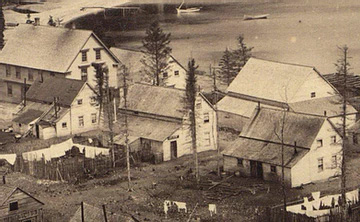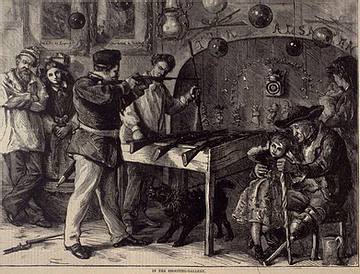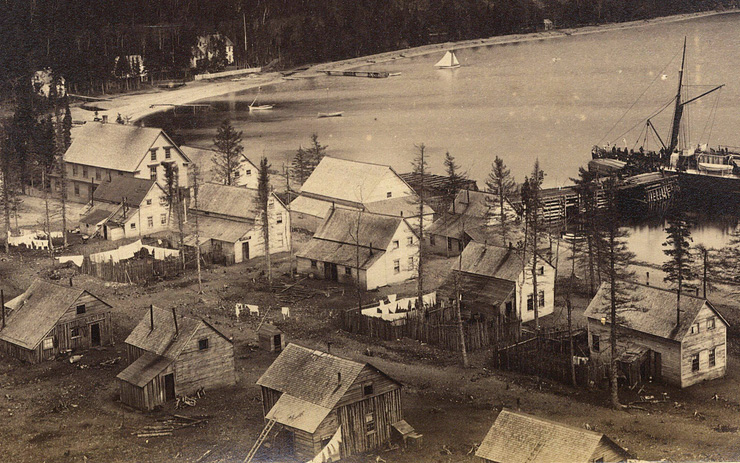 “In the valley between two hills on the south side is situated one of the most valuable copper mines in Newfoundland. A tramway extends from the mine to the wharf in Little Bay, and there is a road to the settlement at the head of Indian bight. A white wooden church, with a spire, has been erected at the southwest end of the dwelling houses, and a wharf projects from the centre of the beach” (Newfoundland and Labrador 1884: Supplement Issue 1 by United States Hydrographic Office).
“In the valley between two hills on the south side is situated one of the most valuable copper mines in Newfoundland. A tramway extends from the mine to the wharf in Little Bay, and there is a road to the settlement at the head of Indian bight. A white wooden church, with a spire, has been erected at the southwest end of the dwelling houses, and a wharf projects from the centre of the beach” (Newfoundland and Labrador 1884: Supplement Issue 1 by United States Hydrographic Office).
January
Temperance was having its effect and on the first day of 1884 Sergeant Wells wrote in his diary that no men had been drunk on the streets of Little Bay over the holiday (Wells 16). On the 5th, Henry Castello got a doctor’s note for missing his court date. He had been charged with breaching the liquor license act (Wells 16). The Twillingate Sun reported that “Sergeant Wells charged Henry Castello with violation of the 2nd section of the License Act. This being the 2nd offence, defendant was fined 75 dols, and costs” (Twillingate Sun, Feb 8, 1884).
The same day the news of what had transpired in Harbour Grace over Christmas hit the town. It was received first by Sergeant Wells via telegraph (Wells, 16) and printed in the Sun that day also (Twillingate Sun, Jan 5 1884). What would come to be known as the Harbour Grace Affray was said in hushed tones all across the island and in Little Bay it was no different. The event would serve to deepen the religious divides and frame future conflicts in an increasingly denominational language. What happened on the 26th of December in Harbour Grace when a parade of the Loyal Orange Association consisting of between four and five hundred people was blocked by a line of over one hundred Catholics was a violent eruption of growing religious tensions that resulted in five deaths and nineteen arrests (Collins).
More bad news arrived on the 26th of January when Sergeant Wells heard of the death of Sergeant Thomas Fennessey who, the previous evening, had been killed “by avalanche of snow at Betts Cove” (Wells, 22). The Sun reported that “his body was found head downward and quite dead” (Twillingate Sun, Feb 8, 1884). His body was to be returned to St. John’s but would have a long wait due to the difficult weather. Ice became a problem for ocean transport by late January this year with the mail ship Plover turned back on the 28th (Wells 22). David Dobbin recalled that year saying “the winter came early with bitter cold and snowstorm after snowstorm closed in the tiny community. Flu’s and colds were rampant and it attacked our house with a vengeance” (Perry, 143).
February
The police had a busy year fighting alcohol and several arrests were made this month. Of particular interest was the local tailor, Thomas Cain, whose drunken conduct included attempting to stab his wife and threatening suicide. They took his guns and “brought him to the lockup for safe keeping” (Wells 39).
Rev. O’Flynn had recently returned from a “pastoral visit to the M’ macq communities” (Coady, 484). On the 8th of February a letter to the Twillingate Sun praised his Temperance cause in the town. They wrote “not long since the Rev. S.O. Flynn started a Temperance Society [he has] upward of 50 persons enrolled as Total Abstainers. May every success attend his efforts in the noble cause of endeavouring to save his fellow creatures from the evils of intemperance. The Rev. M. Fitzpatrick (Presbyterian) has also taken the leadership of a Band of Hope.” They further wrote that Sergeant Wells “is doing not a little to diminish the drinking evils. Some cases of selling liquors without a license have been detected [and] dealt with according to law. These cases will prove a great check and will have a wholesome effect on the community” (Twillingate Sun, Feb 8 1884). There was a new Methodist reverend in town this year, Rev. J. W. Vickers. He and his fellow Methodist ministers “commenced the tour in the circuit” doing group sermons in the various communities until March 17th. Their meeting in Little Bay was presided by Mr. G. Quenby and collected a total of $30.40 from parishioners (Twillingate Sun, April 5, 1884).
The cold weather caused many problems this year. On the 28th of February the Evening Telegram noted that they had not received any mail from Little Bay since the S. S. Plover’s last trip north in early January, stating that “this mail is of especial interest to the families of miners – the telegraph lines being practically closed against them owing to the high charges for messages” (Evening Telegram, Feb 28th, 1884). During the night shift at the mines on the night of the 28th an accident occurred which resulted in the death of a miner named Luke Madden. A tram tipped over dropping rocks eighty feet onto Madden’s leg which fatally wounded him. The doctor was called but could do nothing to save the man’s life (Wells 27).
March
 On the 1st of March Sergeant Wells took statements from the overseer in charge during the accident, William Foran, and the brother of the deceased, John Madden. Foran stated that he considered the shaft they’d been working quite safe and “protected with two rails” while Madden put the blame squarely on Foran saying this was not the first such event and that the shaft in question “had no rail around it whatever” (Wells 28). Wells spent the month of March busting up fights, arresting drunks, and raiding sheebeen houses. The mail south officially closed on the 14th of this month and on the 17th a concert was held in the public hall. His journals close the month by noting on rumours of an upcoming mining strike (Wells 39). Rev. Fitzpatrick and Rev. O’Flynn played large parts in organizing the Temperance movement which was being enforced by Sergeant Wells.
On the 1st of March Sergeant Wells took statements from the overseer in charge during the accident, William Foran, and the brother of the deceased, John Madden. Foran stated that he considered the shaft they’d been working quite safe and “protected with two rails” while Madden put the blame squarely on Foran saying this was not the first such event and that the shaft in question “had no rail around it whatever” (Wells 28). Wells spent the month of March busting up fights, arresting drunks, and raiding sheebeen houses. The mail south officially closed on the 14th of this month and on the 17th a concert was held in the public hall. His journals close the month by noting on rumours of an upcoming mining strike (Wells 39). Rev. Fitzpatrick and Rev. O’Flynn played large parts in organizing the Temperance movement which was being enforced by Sergeant Wells.
April
The police continued their war against liquor and issued numerous summons over the course of April. Houses were raided and fights were busted up. Little Bay had a well-used jail during this time. But Sergeant Wells was getting increasingly annoyed with the hypocrisy of his Constable, as Meaney was occasioned to come home late smelling of liquor himself (Wells, 40).
Not everyone on the Temperance side was happy with the effectiveness of Sergeant Wells’ work. On the 14th the Little Bay correspondent for the Evening Telegram wrote that “law and order [were] slowly improving [but] the rum and beer shops [were] a constant source of trouble. When a change was made in the police force [we] felt sure the illicit sale of rum and beer would become a thing of the past. To a certain extent [it has] but only in part. To explain: A short time ago Henry Castelle was fined $50 and $75 for selling spirits without a license [but Wells] gave him time to dispose of [his rum] the proceeds of which are to liquidate the fines. Another case, John Lamb, manager of the skittle alley, billiard-room, beer-shop and gambling-saloon, has been granted a license to sell malt liquors. This place is a trap for the labouring men of Little Bay; most of their hard earnings fall into Lamb’s hands. [The police] allow beer to be sold at all hours, and skittles to be played on the Sabbath day. [I am] reminding the officials of their duty [. . .] by bringing their delinquencies before them in a public way” (Evening Telegram, April 15 1884).
On the 15th “a very interesting Cricket Match was played at Little Bay” between the Little Bay Pioneers and the the Bett’s Cove Zulus “which resulted in a victory for the former by thirty-eight runs.” The paper reported on the game in play-by-play fashion saying “The Zulus in their 1st Innings, had to face up some sharp bowling” but “in their 2nd Innings were more successful, and great excitement prevailed amongst the spectators, and money was exchanged freely, as the Zulus were drawing on the opponents considerably, and at the finish were only 7 runs behind.” The Little Bay team “did all they could to entertain the Zulus in preparing dinner, and the following night a Bonnet-hop took place in the Public Hall, in which every one enjoyed themselves immensely” (Twillingate Sun, April 23, 1884).
The Evening Telegram reported that several steamers in the Notre-Damn Bay area were trapped by ice.
May
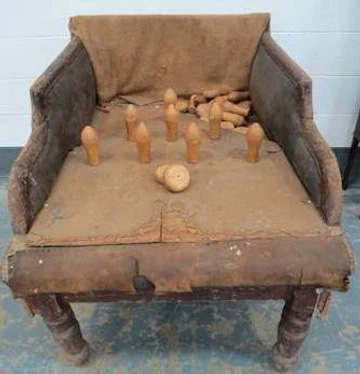 The two policemen spent the day of May 1st in the woods cutting and dragging a flag staff for the new court house. It was “5 feet long and about 9 inches in the butt” and they raised it into position on the 23rd. They spent the rest of the month summoning people for alcohol related charges, including one against the merchant of the provisional store, Johnathan Benson (Wells, 45).
The two policemen spent the day of May 1st in the woods cutting and dragging a flag staff for the new court house. It was “5 feet long and about 9 inches in the butt” and they raised it into position on the 23rd. They spent the rest of the month summoning people for alcohol related charges, including one against the merchant of the provisional store, Johnathan Benson (Wells, 45).
The ongoing battle between the forces of Temperance and the skittle playing forces of the local bar scene was merciless. Skittles was a game similar to bowling in which players toss a beanbag or slide a block of cheese into a set of standing pins called skittles, there are different versions of game-play depending largely on the order in which the pins have to be knocked over.
June
Presbyterianism, the mine-appointed religion, once prominent in the community, had dwindled to less than a dozen people and Rev. Fitzpatrick “left Little Bay by the early part of June 1884. He had rendered valuable service during his year and one half there. He had organized Temperance Societies, conducted the Sunday School which was attended by all denominations, and had taken a lead in the establishing of a public reading room. [. . .] No man was sent to replace Mr. Fitzpatrick. Upon his departure, and the closing of the mission, the Presbytery recommended the appointment of Trustees [to] make arrangements for the use of the Church by [. . .] the Episcopalians and Methodists” (Moncrieff).
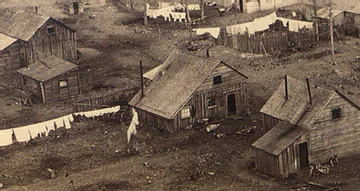 On the 5th of June “the ice blockade [had] been raised and communication by water opened pretty well all over Green Bay” (Evening Telegram June 5, 1884). And on the 8th the remains of Officer Fennessey were finally sent home to St. John’s on the mail steamer, S. S. Plover (Wells, 24). Policing in Little Bay continued its trend of issuing summons after summons for illegal alcohol use. On the 14th a man named John Hamilton gave mining Captain Darrow a punch in the face. He was arrested and sentenced to “two months imprisonment with hard labour” (Wells 47).
On the 5th of June “the ice blockade [had] been raised and communication by water opened pretty well all over Green Bay” (Evening Telegram June 5, 1884). And on the 8th the remains of Officer Fennessey were finally sent home to St. John’s on the mail steamer, S. S. Plover (Wells, 24). Policing in Little Bay continued its trend of issuing summons after summons for illegal alcohol use. On the 14th a man named John Hamilton gave mining Captain Darrow a punch in the face. He was arrested and sentenced to “two months imprisonment with hard labour” (Wells 47).
July
On the 3rd “Sergeant Wells was assaulted by Timothy Vivien, also known as Trim (alias Vivien), or T. Trimmey, a Frenchman [. . .] who stabbed his hand several times with a chisel” while he was performing duties in Ming’s Bight (Wells 49). During this summer “negotiations were being made with the Episcopalians for the sale of the [Presbyterian] Church [and while] these negotiations did not materialize, [. . .] arrangements were made for their temporary occupancy of the Church” (Moncrieff).
A schooner known as Four Brothers left St. John’s for Little Bay with supplies in early July (Evening Telegram July 4, 1884). When the schooner Annie B. arrived in Little Bay this month it was carrying onboard two men that had been found adrift in a dory at sea. Their names were John Lyons and John Adams, the two had become separated from a larger vessel while performing duties in heavy fog. They had survived in the ocean for four days without any supplies – the only thing they’d managed to find to eat was a dead bird that they found floating on the water (Evening Telegram July 21, 1884). The ocean was a turbulent and unpredictable neighbour and not a week later the loss of the Mary Jane was reported, the vessel had left St. John’s for Little Bay earlier that month (Evening Telegram July 27, 1884).
August
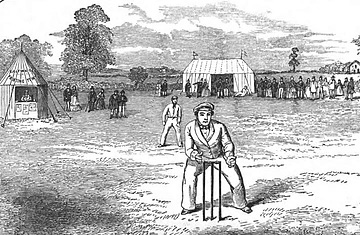 Little Bay fishing “prospects [were] very poor” (Evening Telegram Aug 1, 1884). But while fishing was poor, reading was booming and in a letter to the editor was written, “The Reading-room has been in operation upward of a year, and is largely attended” (Evening Telegram Aug 23, 1884). There was much excitement this August as Mr. Stewart and Mr. Foote were reported to have had a gold find in Ming’s Bight. Also, a cricket match took place this month between the Little Bay Pioneers and “the C. Cubs of Pilley’s Island [where Little Bay] came off victorious by 4 wickets and 11 runs” (Twillingate Sun, Aug 1884). On the 23rd it was written in a letter to the editor that Little Bay had a serious disturbance which “might have resulted in some loss of life and no a little valuable property. As it was, about twenty persons took part in the conflict and one revolver at least was freely used. In this place it is called the aristocratic fight [and] the magistrate acted in a most reprehensible manner, as did also others in authority” (Evening Telegram Aug 23 1884).
Little Bay fishing “prospects [were] very poor” (Evening Telegram Aug 1, 1884). But while fishing was poor, reading was booming and in a letter to the editor was written, “The Reading-room has been in operation upward of a year, and is largely attended” (Evening Telegram Aug 23, 1884). There was much excitement this August as Mr. Stewart and Mr. Foote were reported to have had a gold find in Ming’s Bight. Also, a cricket match took place this month between the Little Bay Pioneers and “the C. Cubs of Pilley’s Island [where Little Bay] came off victorious by 4 wickets and 11 runs” (Twillingate Sun, Aug 1884). On the 23rd it was written in a letter to the editor that Little Bay had a serious disturbance which “might have resulted in some loss of life and no a little valuable property. As it was, about twenty persons took part in the conflict and one revolver at least was freely used. In this place it is called the aristocratic fight [and] the magistrate acted in a most reprehensible manner, as did also others in authority” (Evening Telegram Aug 23 1884).
Baron Fraz von Ellershausen returned from Silver Cliff mine this month but didn’t stay long before saying goodbye to the island of Newfoundland for good and setting off for Spain (Martin). He had been here for ten years and his success “proved to be a flash in the pan” (Bassler). The effect of this German baron on the island was enormous and changed the shape of Newfoundland in many ways, not least of which was the creation of the town of Little Bay. But now he was gone and with him the last of the Germans he’d arrived with. It is curious if German, once the language of the management in Little Bay was ever spoken in the community again. He had started the town and organized its culture, including the dominance of the Presbyterian church, and no doubt, aided in the lack of religious hostility there that had plagued much of the rest of the island. Now Ellershausen was gone and the Presbyterian mission was closed. These events in combination with the influence of the Harbour Grace Affray and the growing Temperance movement could be seen as the closing of Little Bay’s first chapter.
September
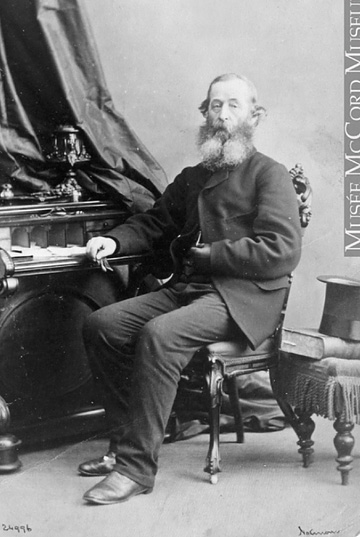 In early September the steamer Lizzie was in town for government work, in particular Light-house servicing. It had “on board Inspector Nevill of the Chairman Board of Works [and] S. McKay, Esq., one of the representatives for [the] district” (Twillingate Sun Sept 6, 1884). On September 11th the Little Bay corresponded telegraphed St. John’s to inform of the situation in the Straits of Belleisle, stating that “starvation stares the people in the face, and government assistance is imperatively necessary” as their fishery was failing (Evening Telegram Sept 11, 1884). Little Bay was doing much better than that and on the 13th a letter to the The Halifax Herald on the mining situation in Little Bay was reported on, the writer feeling that the Herald had exaggerated the prospects to impress their countrymen as many of those now overseeing Little Bay’s mining operations hailed from Nova Scotia. Particular interest was given to the Lady Pond find owned by Mr. J. Wilson (Evening Telegram Sept 13, 1884).
In early September the steamer Lizzie was in town for government work, in particular Light-house servicing. It had “on board Inspector Nevill of the Chairman Board of Works [and] S. McKay, Esq., one of the representatives for [the] district” (Twillingate Sun Sept 6, 1884). On September 11th the Little Bay corresponded telegraphed St. John’s to inform of the situation in the Straits of Belleisle, stating that “starvation stares the people in the face, and government assistance is imperatively necessary” as their fishery was failing (Evening Telegram Sept 11, 1884). Little Bay was doing much better than that and on the 13th a letter to the The Halifax Herald on the mining situation in Little Bay was reported on, the writer feeling that the Herald had exaggerated the prospects to impress their countrymen as many of those now overseeing Little Bay’s mining operations hailed from Nova Scotia. Particular interest was given to the Lady Pond find owned by Mr. J. Wilson (Evening Telegram Sept 13, 1884).
A miner from Little Bay had been killed during operations in Betts Cove by falling rocks. Mr. Alonzo Spriggs was a leading miner and well liked. He was married with two children. His remains were returned to Little Bay on the 14th where he was “interred with Masonic honors.” This death seems to have impacted the community greatly and his funeral drew much attention. In a letter written to the newspaper was said “In a small community like this, such a sudden death causes great excitement” (Twillingate Sun Sept 20, 1884). The steamers came and went carrying the living and the dead. The steamer Leopard was in town carrying the members of the supreme court circuit (Twillingate Sun Sept 20 1884). It was said that the “practice was much more profitable in the Northern settlements, and especially in Little Bay, than in the Southern harbours” (Evening Telegram Sept 26 1884). The S. S. Carn Brea arrived in town on the 16th and stayed until the 27th. It brought many supplies from Europe before leaving for New York. The vessel was “built of iron, deck and all, and [. . .] steered with steam machines [and was described as] the finest steamer ever arrived” (Twillingate Sun Oct 2 1884).
October
Praise for the Lady Pond find continued and on October 6th was written that it gave “unmistakable indications that is contains rich and large deposits of that ore, and is spoken of as being the mine of the future [. . .] however, of the low price of copper abroad, there is a difficulty in producing the necessary capital with which to work it, and copper mining generally throughout the island is languishing from the same cause. Wages are much lower than formerly” (Evening Telegram Oct 6 1884).
On the 14th the house of Mr. Henry Castello was “destroyed by fire. William Brien who happened to be returning from the mine at 4:30 a.m. observed flames issuing from the house. He aroused Castello who with wife and child managed to escape.” On the 20th “two men had a narrow escape from death” in the mines (Twillingate Sun Nov 1, 1884). Sergeant Wells’ son accidentally shot Constable Meaney in the arm on the 27th and the paper in St. John’s, echoing more modern gun-safety debates, wrote “too much care to over-loaded weapons cannot be taken” (Evening Telegram Dec 4, 1884).
November
On the 19th the S. S. Anerby arrived from Liverpool in hard shape. The vessel had hit bad weather during the trip and “with very high seas, the ship laboured heavily” and required repair “by the able management and machinists of Little Bay” (Twillingate Sun Nov 29 1884). In other boat news, Mr. J. Benson was “having a large craft build” by the Evans’ family. Little Bay was doing better than more Northern communities and the Little Bay correspondent for the Sun reported the need for government assistance up north as many were facing starvation (Twillingate Sun Nov 22 1884). The difficulty of the police in handling the area is felt with an officer off duty. One of the two men must guard the prisoners while the other walks the beat. During this time Constable Meany broke his already shot-up arm and Sergeant Wells was called away to Twillingate so a Constable named Sparks was dispatched to the area (Wells 58).
December
The Episcopalians started building their own church this month (Evening Telegram Dec 4 1884). Sergeant Wells returned on the 7th, likely happy to find the town still intact (Wells 58). Peyton visited the town at this time to conduct land surveys. The falling prices of copper showed its impact and it was said, “Little Bay mines have evidently, if the falling off of the shipments to Great Britain are a criterion of their status, seriously felt the effect of the decline in values. In 1884 the receipts in Liverpool and Swansea were only 224 long tons fine, as compared with 1,185 long tons in 1883” (Mineral Resources of the United States 1885).
The first census of the town was done this year. It recorded a population of 1538 in 286 families. 832 Roman Catholics and 706 Protestants largely Church of England or Wesleyan. Of the 696 children 179 attended school. There were 252 miners, 55 Mechanics, 27 Clerks, 1 Doctor, 2 Clergymen, 10 Merchants, 8 Farmers, 8 Lumbermen, and 29 Fishermen. 56 born in the Colonies, 28 born in England, 13 born in Scotland, 2 born in Ireland, and 13 born of other countries. Of the over 1500 people living there I have been able to identify the 200 or so you’ll find listed at the bottom. And that’s it for 1884!
Public Hall (houses bazzars, musical and theatrical performances, and the reading room)
Court House (contains jail) – Magistrate Blandford, Way Officers Wells and Meaney
Post Office (contains telegraph and customs offices) – Mr. Walsh
Medical Office – Dr. Joseph and Dr. Henderson
Mining Offices – Mr. White, Mr. Darrow, and Mr. Curtis
The Company’s Cottage (near the public wharf in The Bight)
Little Bay Hotel (near the public wharf in The Bight) – Mr. Courtney
Skittle Alley (Skittles, Billiards, Shooting Gallery, and Jewelry shop) – Mr. Lamb
Huxter’s Public House – Mr. Huxter
Benson’s Provisions Store – Mr. Benson
Loading Wharf Store
Redden Brothers Shop – Mr. Redden and Mr. Redden
Cain’s Taylor Shop – Mr. Cain
Blacksmith’s shop – Mr. Ross
Tinsmith’s shop – Mr. Malcolm
Shoemaker’s shop – Mr. McArthur
Watchmaker’s shop (jewelry, watches, clocks, and silverware) – Mr. Purchase
Druggist’s shop – Mr. McCarthy
Other Merchants include – Mr. Boyde, Mr. Thrope, Mr. Sharp, and Mr. Burke
Notre Dame Lodge (Masonic Lodge)
Presbyterian Church – Rev. Fitzpatrick
Presbyterian School (100 students)
RC Church – Her Lady of Mount Carmel Parish – Rev. O’Flynn
RC School in The Bight – Mr. Hanrahan
RC School at Loading Wharf – Mr. Coady
C of E Church – St. Luke’s – Rev. Pittman
C of E School – Mr. Burgess
Methodist Church – Rev. Vickers
Notre Dame Club – The Little Bay Pioneers (Cricket team)
Little Bay Rifle Club
Little Bay Brass Band
Little Bay Choral Society
Little Bay Music and Drama Club
Terra Nova Billiard and Reading Room Club
Sons of Temperance / Band of Hope (Temperance movement)
Shebeen houses (unlicensed alcohol)
Miner’s Union
Little Bay Road Board
Little Bay Education Board
Sources:
Newfoundland Census 1884
Evening Telegram 1884
Twillingate Sun 1884
Newfoundland Supplement of the US Hydrographic Office 1884
Mineral Resources of the United States 1885
Photography of Simeon H. Parsons 1884
Moncrieff, A History of the Presbyterian Church in Newfoundland 1966
Martin, Once Upon a Mine 1983
Bassler, Vikings to U-Boats 2006
Perry, In Deep Water 2006
Coady, Lives Recalled 2010
Collins, The Harbour Grace Affray 2011
Wells, All Quiet 2012
- Archibald, Mr. (Evening Telegram)
- Badge (Twillingate Sun)
- Bartlett, Jesse William (Civilian Marriages) – moved to Tilt Cove by 1897
- Bartlett, Elizabeth Frecker – wife of Jesse (Civilian Marriages)
- Benson – provisions store merchants (Wells)
- Benson, Johnathan (Vital Stats, 1753-1893)
- Benson, Sarah Jane – wife of Johnathan (Vital Stats, 1753-1893)
- Benson, John Joseph – born to Johnathan and Sarah (Vital Stats, 1753-1893)
- Berteau, E. (Twillingate Sun)
- Bishop, George (Canadian Marriages 1661-1949)
- Bishop, Emma – wife of George (Canadian Marriages 1661-1949)
- Bishop, Mary – born to George and Emma (Canadian Marriages 1661-1949) in Glace Bay 1905
- Blandford, John B. – magistrate (Twillingate Sun, 1880)
- Boggan, James (Wells)
- Bond, William (Vital Stats, 1753-1893)
- Bond, Adelaide (Vital Stats, 1753-1893)
- Bond, Hubert George – born (Vital Stats, 1753-1893)
- Bond, William (Vital Stats, 1753-1893)
- Bond, Frances Purchase (Vital Stats, 1753-1893)
- Bond, William – born to William (Vital Stats, 1753-1893)
- Bouzane, James Michael – tree cutting (Deck’s Awash, Vol. 17 No.5)
- Bouzane, Jane Sandy – wife of James (deduced)
- Bouzane, Thomas M. – tree cutting (Deck’s Awash, Vol. 17 No.5)
- Bouzane, Catherine Colbert – wife of Thomas (deduced)
- Bousan, John – born (1921 Census)
- Boyde, Thomas – merchant (Supreme Court documents)
- Boyde, Eliza Stuckless – wife of Thomas (deduced)
- Boyde, James Walter – son of Thomas and Eliza (deduced)
- Boyde, Laura Jane – daughter of Thomas and Eliza (deduced)
- Boyde, Thomas Abraham – son of Thomas and Eliza (deduced)
- Breen (Wells)
- Brien, William – miner (Twillingate Sun)
- Brinford, Janet (Twillingate Sun)
- Brinford, Margaret (Twillingate Sun)
- Buckley, Thomas (Civilian Births)
- Buckley, Bridget Dwyer – wife of Thomas (Civilian Births)
- Buckley, Ronald – born to Thomas and Bridget (Civilian Births)
- Burgess, E. R. – church trustee (Moncrieff)
- Butt, John – trader (Supreme Court documents)
- Byrne, Samuel – miner (Supreme Court documents)
- Cain, Thomas – proprietor of “Cain’s Taylor Shop” (Wells)
- Cain, Mrs. – wife of Thomas (Wells)
- Carry, William – labourer (Supreme Court documents)
- Castelle, Henry (Twillingate Sun)
- Castello, Henry (Twillingate Sun)
- Castello – wife of Henry (Twillingate Sun)
- Castello – child (Twillingate Sun)
- Chancey, Laurence (Wells)
- Chisham, Daniel (Wells)
- Chubb, John (Vital Stats, 1753-1893)
- Chubb, Sarah – wife of John (Vital Stats, 1753-1893)
- Chubb, Cornelius – born to John and Sarah (Vital Stats, 1753-1893)
- Clair, Moses (Supreme Court documents)
- Colborne, John (Vital Stats, 1753-1893)
- Colborne, Annie Snelgrove – wife of John (Vital Stats, 1753-1893)
- Conway, William – miner (Wells)
- Cook, Annie (1921 Census)
- Cook, James – born to Annie (1921 Census)
- Cooney, Edward – labourer (Wells)
- Cooper, Richard (Vital Stats, 1753-1893)
- Cooper, Sophia – wife of Richard (Vital Stats, 1753-1893)
- Cooper, Thomas J. – born to Richard and Sophia (Vital Stats, 1753-1893)
- Corbett, John – labourer (Supreme Court documents)
- Costigan – captain (Twillingate Sun)
- Croak – miners (Atlantic Guardian, Sept 1948)
- Curtis, Francis Edward – widower, mine overseer (Methodist Marriages)
- Curtis, Louisa Susanna Traverner – wife of Francis (Methodist Marriages)
- Dadan (Twillingate Sun)
- Darrow – mine management (Wells)
- Dean, Mr. (Twillingate Sun)
- Diem – church trustee (Moncrieff)
- Dobbin, David Thomas – miner (Perry)
- Dobbin, Clara Breen – wife of David (Perry)
- Dobbin, Sarah – child of David and Clara (Perry)
- Dobbin, Mary – child of David and Clara (Perry)
- Dobbin, Madeline – child of David and Clara (Perry)
- Dobbin, Francis – child of David and Clara (Perry)
- Donahue, Maliche (Supreme Court documents)
- Dunphy, Miss (Twillingate Sun)
- Dwyer, Robert (Wells)
- Eddison, Mrs. (Twillingate Sun)
- Ellershausen, Franz- mine management (Martin)
- Elward, Miss (Twillingate Sun)
- Fahey (RC cemetery)
- Fitzpatrick, J. R. – Rev. Presbyterian Church (Moncrieff)
- Flemming, James – labourer (Wells)
- Flemming, Peter (Wells)
- Foot – mine (Twillingate Sun)
- Foot, Annie – Witness (Methodist Marriages)
- Foote, Mr. (Twillingate Sun)
- Foran, William – mine management (Wells)
- Gillis, Allan (Vital Stats, 1753-1893)
- Gillis, Johanna Head – wife of Allan (Vital Stats, 1753-1893)
- Gillis, John W. – born to Allan and Johanna (Vital Stats, 1753-1893)
- Gregory, Peter (Wells)
- Hacker, Frany (Vital Stats, 1753-1893)
- Hacker, Sarah – wife of Frany (Vital Stats, 1753-1893)
- Hacker, Mary Emily – born to Frany and Sarah (Vital Stats, 1753-1893)
- Hamilton, John (Wells)
- Head, Thomas – miner (Atlantic Guardian, Sept 1948)
- Head, Mary – wife of Thomas (Atlantic Guardian, Sept 1948)
- Head, John – son of Thomas and Mary (deduced)
- Head, Anastasia – daughter of Thomas and Mary (deduced)
- Head, Mary – daughter of Thomas and Mary (deduced)
- Head, Sylvester James – son of Thomas and Mary (deduced)
- Head, Lawrence – son of Thomas and Mary (deduced)
- Head, James Thomas – son of Thomas and Mary (Atlantic Guardian, Sept 1948)
- Head, Patrick Joseph – son of Thomas and Mary (deduced)
- Hearn P. (Twillingate Sun)
- Huestis, John Lamb (Vital Stats, 1753-1893)
- Huestis, Joseph B. (Massachusetts Marriages, 1841-1915)
- Huestis, Katherine Mcnutt – wife of Joseph (Massachusetts Marriages, 1841-1915)
- Huestis, Florence Alice – daughter of Joseph and Katherine (Massachusetts Marriages, 1841-1915)
- Huffman, Henry – labourer (Supreme Court documents)
- Inder, George – born (1921 Census)
- Joseph, Louis – doctor (Wells)
- Kein, Thomas (Supreme Court documents)
- Kennedy, Patrick (Vital Stats, 1753-1893)
- Kennedy, Mary Ann – wife of Patrick (Vital Stats, 1753-1893)
- Kennedy, Thomas Robert – born to Patrick and Mary Ann (Vital Stats, 1753-1893)
- Keough, John – labourer (Supreme Court documents)
- Lamb, John – proprietor of “Skittle Alley” (Wells)
- Lind, Henry – company storekeeper (Taylor)
- Lind, Mrs. – wife of Henry (deduced)
- Lind, William – son of Henry (Taylor)
- Lind, Robert George – son of Henry (Taylor)
- Lind, James Marshall – son of Henry (Taylor)
- Lind, Francis Thomas – son of Henry (Taylor)
- Lewis, Mary Ann – wife of Samuel (Vital Stats, 1753-1893)
- Lewis, Samuel (Vital Stats, 1753-1893)
- Lewis, Bessie Boyden – born to Samuel and Mary Ann (Vital Stats, 1753-1893)
- Locke, Frederick – Witnesses (Methodist Marriages)
- Locke, Frederick (Vital Stats, 1753-1893)
- Locke, Hermenas – born (Vital Stats, 1753-1893)
- Locke, Israel – miner (Vital Stats, 1753-1893)
- Locke, Margaret (Vital Stats, 1753-1893)
- Locke, Martina Head (Vital Stats, 1753-1893)
- Louis, Mary Ann – Witnesses (Methodist Marriages)
- Luffman, Henry (Vital Stats, 1753-1893)
- Luffman, Phoebe Maud Killoway – born (Vital Stats, 1753-1893)
- Luffman, Sarah (Vital Stats, 1753-1893)
- Lynch, Mr. (Evening Telegram)
- MacLeod, Charles – church trustee (Moncrieff)
- MacNeil, Angus – bachelor, engineer (Methodist Marriages)
- MacNiel, Asenath Hopkins – spinster (Methodist Marriages)
- Macvicar, James – church trustee (Moncrieff)
- Malcolm (Twillingate Sun)
- Martelle, Alexander (Wells)
- Martin, John – labourer (Supreme Court documents)
- Martin, Patrick “Dublin” (Wells)
- Martin, Patrick (Wells)
- McKay (Twillingate Sun)
- McKinnon, J. (Twillingate Sun)
- McLean, John (Wells)
- McLean, Michael (Supreme Court documents)
- McVicar, Frederick Stephen – born (Vital Stats, 1753-1893)
- McVicar, James (Vital Stats, 1753-1893)
- McVicar, Neil – Witnesses (Methodist Marriages)
- McVicar, Sarah (Vital Stats, 1753-1893)
- Meaney – Constable (Wells)
- Morrison, Arthur (Wells)
- Mullowny, Stephen – labourer (Supreme Court documents)
- Noseworthy, Thomas (Wells)
- O’Flynn, Stephen – Rev. Catholic Church (Moncrieff)
- Parsons, Richard (Land survey)
- Phillips, Charles – engineer (Supreme Court documents)
- Pittman, Arthur – Rev. Church of England (Moncrieff)
- Pittman, Mrs. (Evening Telegram)
- Quenby, G. (Twillingate Sun)
- Randell, George W. – Witnesses (Methodist Marriages)
- Reddin, C.O.B. (Twillingate Sun)
- Reddin, William – merchant (Supreme Court documents)
- Rideout, Henry – labourer (Supreme Court documents)
- Ryan, John (Supreme Court documents)
- Sheppard (Wells)
- Smart, John (Vital Stats, 1753-1893)
- Smart, Mary Ann (Vital Stats, 1753-1893)
- Smart, Roseanna – born (Vital Stats, 1753-1893)
- Smythe, Mr. (Evening Telegram)
- Sparks – Constable (Wells)
- Spencer, Mary Maude – born (Vital Stats, 1753-1893)
- Spencer, Susanna (Vital Stats, 1753-1893)
- Spriggs, Alonzo – miner (Twillingate Sun)
- Spriggs, Mrs – wife of Alonzo (Twillingate Sun)
- Spriggs – child of Alonzo (Twillingate Sun)
- Squires, Jeremiah (Wells)
- St. Clare, John (Wells)
- Stewart, Henry (Wells)
- Stewart, John Robert – mine management (Martin)
- Stewart, Adelaide Delphena Boyde – wife of John (Vital Stats, 1753-1893)
- Stewart, Annie Eliza – born to John and Adelaide (Vital Stats, 1753-1893)
- Stewart, Walter – son of John and Adelaide (deduced)
- Stewart, Mary (Wells)
- Stuckless, James – born (1921 Census)
- Stuckless, Susanna (1921 Census)
- Taylor, Stanley – miner (Twillingate Sun)
- Taylor, Esther (Vital Stats, 1753-1893)
- Taylor, George (Vital Stats, 1753-1893)
- Taylor, Hettie May – born (Vital Stats, 1753-1893)
- Thompson, J. C. (Twillingate Sun)
- Thompson, John (Wells)
- Tilly, Joseph (Vital Stats, 1753-1893)
- Tilly, Mary (Vital Stats, 1753-1893)
- Tilly, Thomas James – born (Vital Stats, 1753-1893)
- Traverner, Gilbert Henry – born (Vital Stats, 1753-1893)
- Traverner, Joseph Henry (Vital Stats, 1753-1893)
- Traverner, Mary E – Witness (Methodist Marriages)
- Traverner, Mary Elizabeth (Vital Stats, 1753-1893)
- Vickers, J. – Methodist reverend (Twillingate Sun)
- Wall, T. (Twillingate Sun)
- Wallace (Twillingate Sun)
- Walsh, Patrick – miner (Encyclopedia of Newfoundland)
- Walsh, Sarah – wife of Patrick (Encyclopedia of Newfoundland)
- Walsh, William Joseph – son of Patrick and Sarah (Encyclopedia of Newfoundland)
- Walsh, James – licensed dealer of liquors (Supreme Court documents)
- Walsh, Richard – postmaster (Newfoundland Almanac, 1881)
- Walsh, W. (Twillingate Sun)
- Wells, Thomas Edward – Police Sergeant (Wells)
- Wells, Mary Jane – wife of Thomas (Wells)
- Wells, Edith – daughter of Thomas and Mary (Wells)
- Wells, Doyle – son of Thomas and Mary (Wells)
- Wheeler, Grace (Vital Stats, 1753-1893)
- Wheeler, John (Vital Stats, 1753-1893)
- Wheeler, Mary Ann – born (Vital Stats, 1753-1893)
- White, Thomas – mine management (Wells)
- Whitten, Robert – labourer (Supreme Court documents)
- Witten, Robert – miner (Wells)
- Young, Fanny Locke – widow (Methodist Marriages)
- Young, Fanny Locke (Vital Stats, 1753-1893)
- Young, Frederick – bachelor, miner (Methodist Marriages)
- Young, Frederick (Vital Stats, 1753-1893)
- Birth of Mary Ash – maiden name unknown (1921 Census)
- Birth of Mary Catherine Evely – maiden name unknown (1921 Census)
- Birth of Maud Critch – maiden name unknown (1921 Census)

